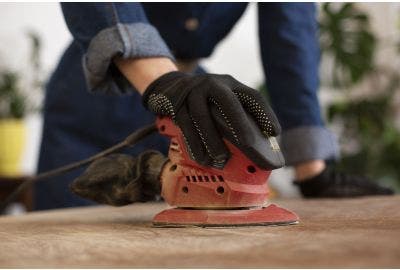When achieving a professional finish on any surface, choosing the right sandpaper is essential. Sandpaper isn’t just about grit size – the P grade system plays a major role in selecting the right type for each task. Understanding P grades helps DIY enthusiasts, woodworkers, and professionals pick the most suitable sandpaper to prepare surfaces accurately and efficiently.
This article explains P grades, their differences from grit size and their importance. Learn how P grades affect results and how to select the right sandpaper for each sanding stage to ensure smoother finishes and save time.
What Are P Grades in Sandpaper?
P grades refer to a classification system that helps users understand the size and distribution of abrasive particles on sandpaper. This system was introduced by the Federation of European Producers of Abrasives (FEPA) to create a standard approach, particularly in woodworking and fine-finishing applications. The P grade number on sandpaper indicates the average size of the abrasive particles, which is essential for selecting the right sandpaper for specific tasks.
Unlike traditional sandpaper grit classifications, P grades are mostly used in Europe and are particularly valuable for precision work. The consistency and even distribution of abrasive particles in P grade sandpaper offer more controlled results, making it a popular choice for projects where surface quality is essential.
How P Grades Differ from Grit Size

While P grades and sandpaper grit size help to define sandpaper coarseness, they have key differences. P grades focus on particle size distribution, with abrasive particles evenly spread to produce consistent results. On the other hand, traditional grit sizes measure only the average particle size, which can lead to variations in sanding quality.
P grade sandpapers are commonly used in European standards, while non-P grade grit sizes are often associated with American standards. For example, a P80 sandpaper and an 80-grit sandpaper may seem similar, but a P80 provides more consistent abrasion due to its regulated particle distribution. This distinction is especially useful for projects where smoothness and uniformity are required.
The Numbering System of P Grades
P grades are organised in a numbered system, ranging from P12, which is very coarse, to P2500, which is extremely fine. Lower P grade numbers indicate coarser sandpaper, designed to remove material quickly, while higher numbers correspond to finer grits for detailed finishing. This numbering helps users select the right grade for each stage of a sanding project, from rough shaping to delicate polishing.
For instance, coarse grades like P40–P60 are ideal for initial material removal on rough wood, while finer grades like P180–P240 are suited for smoothing surfaces before applying finishes.
Why P Grades Are Important for Surface Preparation

Using the correct P grade is essential for achieving the desired finish and preparing surfaces properly. Each material—whether wood, metal, or plastic—requires a specific P grade to remove imperfections, smooth surfaces, or create a texture suitable for finishes like paint or stain. Choosing the right P grade can mean the difference between a flawless finish and a rough, uneven surface, which is why sandpaper for surface preparation is key.
Different surfaces need different P grades for optimal results. For instance, wood may require coarser grades for initial shaping, while metal might benefit from finer grades to avoid scratches. Incorrect P grades can lead to unsatisfactory results, like visible scratches or even damage to the material. The right P grade not only improves the quality of the finish but also saves time by reducing the need for additional sanding or reworking.
Common Applications for Different P Grade Sandpapers
Different P grades suit various tasks, from heavy material removal to fine finishing. Here’s a breakdown of typical uses for sanding tools across each range:
| P Grade Range | Coarseness | Typical Applications | Example Projects |
|
P40–P60 |
Coarse | Heavy material removal, shaping, paint stripping | Removing old paint from wood, shaping edges |
|
P80–P120 |
Medium | Intermediate sanding, smoothing minor imperfections | Preparing wood for finishing, smoothing rough surfaces |
|
P180–P240 |
Fine | Surface preparation for finishes like paint or stain | Final sanding on furniture before varnish application |
|
P400–P800 |
Very Fine | Polishing, preparing metal and plastic surfaces | Polishing metal, and smoothing plastic for glossy finish |
|
P1000–P1500 |
Ultra Fine | High-gloss polishing, automotive detailing | Buffing car paint, refining plastic for a mirror finish |
Examples of Common Applications
- Wood Preparation for Varnish: When sanding a wooden table for varnish, start with P80 to smooth rough areas or remove an old finish. Progress to P120 for evenness, and finish with P240 to prepare the surface for varnish application.
- Metal Surface Prep for Painting: For prepping a metal surface, begin with P60 to remove rust or paint. Move to P180 to smooth scratches, and finish with P400 to create a polished surface that’s ready for paint.
- Plastic Finishing: For a smooth, polished plastic surface, use P120 for initial smoothing, P240 to refine, and finish with P600 for a glossy effect ideal for clear or coloured finishes.
- Automotive Detailing for Scratch Removal: To polish a car panel, start with P320 to reduce scratches, use P800 to refine, and finish with P1500 for a high-gloss, paint-ready surface.
How to Choose the Right P Grade for Your Project

Selecting the correct P grade depends on the material you’re working with and the finish you want to achieve. Here’s a step-by-step guide to help:
- Identify the Material: Different materials respond better to specific P grades. For instance, wood generally requires coarser sanding sheets for initial sanding, while metal may benefit from finer grades to avoid scratches.
- Define Your Project Goal: Are you shaping the material, removing imperfections, or preparing for a finish? Coarser grades (P40–P80) are suitable for material removal and shaping, while finer grades (P180+) are best for smooth finishing.
- Test Gradually: Start with a medium P grade if unsure, then adjust as needed to achieve the desired smoothness. Moving from a coarser to a finer grade step-by-step reduces the risk of over-sanding and results in a better finish.
Keep a Range on Hand: Having a selection of P grades available makes it easier to progress through each stage of sanding without interruption.
How P Grade Impacts Finishing Results

The P grade of sandpaper directly influences the quality of your finishing results. Using the correct P grade reduces the chances of visible imperfections like scratches, gouges or uneven surfaces. Starting with a coarser grade to shape or remove material, and then gradually moving to finer grades, creates a smooth, polished finish suitable for painting, staining or varnishing.
Finishing projects often require a series of sandpapers at varying P grades, progressing from rough to fine. For instance, woodworking projects might start with a P80 for shaping, move to a P120 for smoothing and finish with a P240 for final preparation before applying a finish. Each stage of grading improves the surface, creating a professional-looking result that’s free from unwanted marks or texture.
Understanding P grades is key to achieving the best possible finish on your projects. By selecting the right P grade for each stage of sanding, you can significantly improve the quality and appearance of the final result. From coarse grades for material removal to fine grades for finishing, each P grade plays a role in achieving smooth, well-prepared surfaces.
Experimenting with different P grades can help you find the ideal approach for each material and finish type. For more guidance and to take a look at Heamar’s full range of sanding tools feel free to contact us.






















